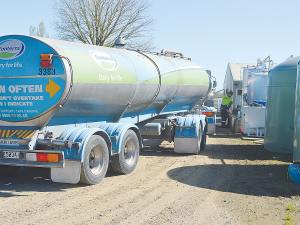Fonterra slashes forecast milk price, again
Fonterra has slashed another 50c off its milk price forecast as global milk flows shows no sign of easing.
 Fonterra has raised the midpoint of the 2024/25 season forecast Farmgate Milk Price by 50 cents to $10/kgMS.
Fonterra has raised the midpoint of the 2024/25 season forecast Farmgate Milk Price by 50 cents to $10/kgMS.
Fonterra farmers are in line for a record milk price of $10/kgMS this season.
The co-operative today raised the midpoint of the 2024/25 season forecast Farmgate Milk Price by 50 cents to $10/kgMS.
The new forecast range of $9.50-$10.50/kgMS reflects the ongoing strength of the global market.
“We’re committed to providing farmers the highest sustainable milk price, so I'm pleased to announce another lift in the forecast for the season,” says Fonterra chief executive Miles Hurrell.
“We’re seeing a recovery of demand in Greater China as domestic milk production rebalances and demand from Southeast Asia continues to be strong.
“Looking at supply, milk production out of the US and Europe continues to be impacted by local factors, while production out of most regions of New Zealand has increased.
“We’re continuing to monitor factors that may influence global supply and demand dynamics, including any potential impact from heightened geopolitical uncertainty,” says Hurrell.
Fonterra’s previous best milk price was $9.30/kgMS, paid in 2021-22.
More than 150 people turned up at Parliament recently to celebrate the 20th anniversary of Horticulture New Zealand (HortNZ).
Biosecurity New Zealand says Kiwis should continue to keep an eye out for yellow-legged hornets (Vespa velutina) over the holiday season.
The Push-Up Challenge, an event which combines mental health and fitness, is set to launch in New Zealand in 2026.
Last month's Agritechnica event led to a wide group of manufacturers celebrating successes when the 2026 Tractor of the Year Competition winners, selected by a panel of European journalists, were announced in Hanover Germany.
According to the latest Federated Farmers banking survey, farmers are more satisfied with their bank and less under pressure, however, the sector is well short of confidence levels seen last decade.
Farmer confidence has taken a slight dip according to the final Rabobank rural confidence survey for the year.
President Donald Trump’s decision to impose tariffs on imports into the US is doing good things for global trade, according…
Seen a giant cheese roll rolling along Southland’s roads?